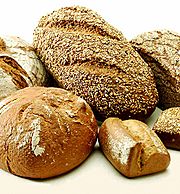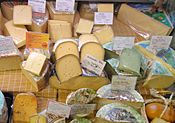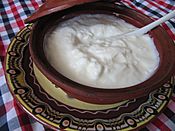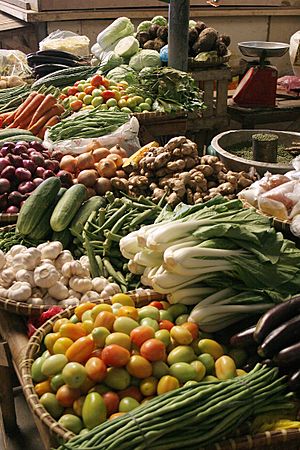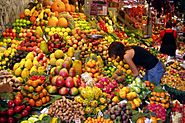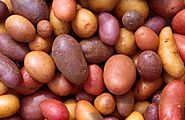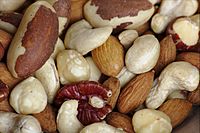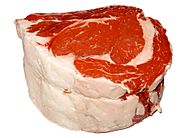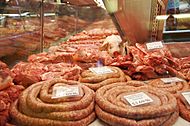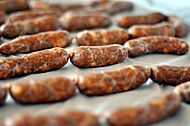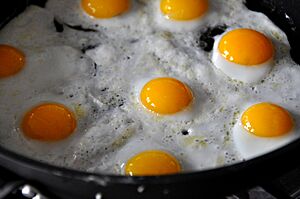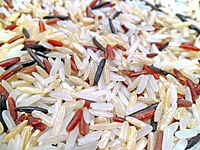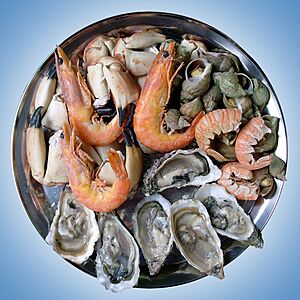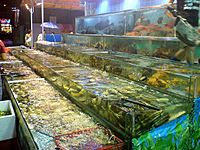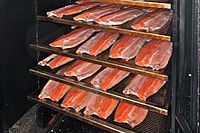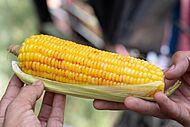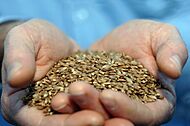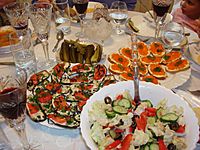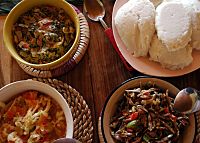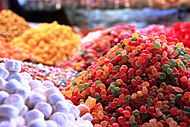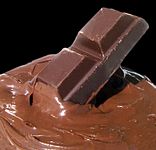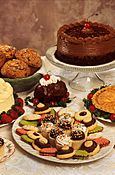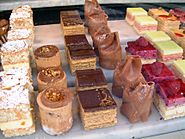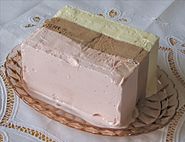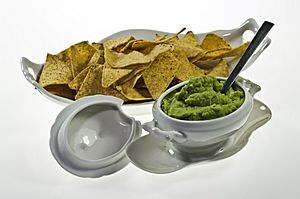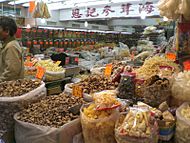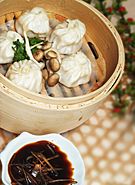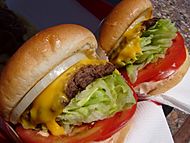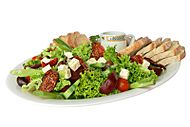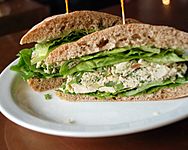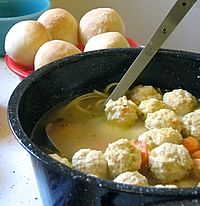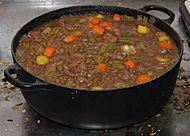Lists of foods facts for kids
Food is anything we eat to give our bodies energy and help us grow. It comes from plants, animals, or even fungi (like mushrooms!). Food gives us important things called nutrients, such as carbohydrates (for energy), fats, proteins (for building muscles), vitamins, and minerals. When we eat, our bodies use these nutrients to make energy, stay alive, and grow strong.
This article will help you explore different types of foods, grouped into helpful categories.
Exploring Different Foods
Baked Goodies
Baked goods are foods cooked using dry heat, usually in an oven. Think of delicious cakes and breads!
Breads
Bread is a very old and important food, made from flour and water, then baked. People all over the world have eaten bread for thousands of years. It's a "staple food," meaning it's a main part of many people's diets.
Cereal Grains
Cereals are the seeds of certain grasses. Grains like corn, wheat, and rice provide about half of all the calories people eat every year! You can grind grains into flour for bread or noodles, or boil them to eat as they are. Many cereals are staple foods, giving people lots of energy.
Dairy Delights
Dairy products are foods made from the milk of mammals, like cows, goats, or sheep. They are usually packed with energy.
- List of dairy products
- List of butter dishes
- List of cheeses
Edible Plants
Many parts of plants are yummy to eat!
Fruits
In everyday talk, fruits are the sweet or sour parts of a plant that we can eat raw, like apples, oranges, or strawberries. But in science, "fruit" also includes things like bean pods, corn kernels, and tomatoes!
Tubers
Not all tubers are edible, but some are very common foods like potatoes, sweet potatoes, and yams. Tubers are special plant parts that grow underground and store nutrients. Plants use them to survive winter or dry times.
Vegetables
In cooking, a vegetable is any edible plant or plant part that we cook or eat raw.
-
Several tasty fruits
Edible Fungi
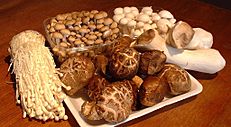
Edible fungi are mushrooms that are safe and tasty to eat. They can grow above or below ground. To be considered edible, they must not be poisonous and should have a good taste and smell.
Edible Nuts and Seeds
A nut is a fruit with a hard shell and a seed inside, which doesn't open on its own. In cooking, we call many dried seeds "nuts," but botanically, only certain ones are true nuts. Many seeds are edible and provide a lot of our daily calories, especially from cereals, legumes, and nuts. Seeds also give us cooking oils, drinks, and spices.
Legumes
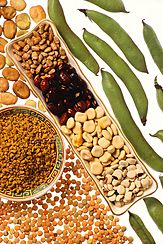
Legumes are plants grown for their seeds, like beans and lentils. They are also used to feed farm animals and to help soil become healthier. Legumes are special because they have bacteria in their roots that help them take nitrogen from the air, which is good for the plant and the soil. Famous legumes include peas, beans, lentils, and peanuts.
Meat
Meat is animal flesh that people eat. Humans have hunted animals for meat since ancient times. Today, we eat meat from many animals like chickens, sheep, pigs, and cattle.
-
A standing rib roast, a cut of beef
-
Various meats
Eggs
Eggs are laid by female animals of many species, including birds, reptiles, and fish. People have eaten eggs for thousands of years. A bird or reptile egg has a protective shell, egg white (albumen), and egg yolk (vitellus). Chicken eggs are the most commonly eaten eggs by humans.
Rice
Rice is a very important grain, especially in many parts of Asia. It's the seed of a plant and is a staple food for over 4 billion people!
Seafood
Seafood is any sea life that people eat. This mainly includes fish and shellfish. Shellfish are creatures like crabs, shrimp, and clams. Fish has been a key source of protein for humans throughout history.
-
Preparing smoked salmon
-
Cooked lobster
Staple Foods
A staple food is something eaten regularly and in large amounts, making up a big part of a person's diet. It provides most of the energy and many other nutrients needed. Most people rely on just a few staple foods. Common plant staples come from cereals like wheat, barley, corn, or rice, or from starchy tubers like potatoes and yams.
Prepared Foods
These are foods that have been cooked or processed in some way.
Appetizers
Appetizers, also called hors d'oeuvres, are small food items served before the main meal. They are often eaten by hand.
Condiments
A condiment is something like a sauce or spice added to food to give it a special flavor or make it taste better.
Sweet Treats (Confectionery)
Confectionery refers to sweet food items, usually rich in sugar. This includes sweet pastries, cakes, candies, chocolates, and chewing gum.
Convenience Foods
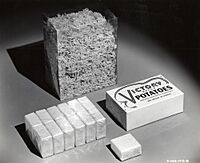
Convenience food, also known as processed food, is food that is prepared commercially to be easy and quick to eat.
Desserts
-
An assortment of desserts
-
Small petit fours
Dessert is usually a sweet course served at the end of a meal. It can include cakes, ice cream, fruits, and more.
Dips, Pastes, and Spreads
- Dips: A dip or dipping sauce is a common extra for many foods. You dip food into it to add flavor or texture.
- Pastes: Food paste is a thick, soft mixture used in cooking or eaten directly as a spread. Pastes are often very flavorful.
- Spreads: Spreads are foods that you can spread, usually with a knife, onto bread, crackers, or other foods. They add flavor and texture.
Dried Foods
-
Various dried foods
Drying is an old way to preserve food by removing water. This stops bacteria from growing. People have been drying food for thousands of years to make it last longer.
Dumplings
-
Dumplings with a dipping sauce
Dumplings are cooked balls of dough. They can be made from flour, potatoes, or bread, and might have fillings like meat, fish, vegetables, or even sweets. They can be boiled, steamed, fried, or baked.
Fast Food
-
Lamb shish kebab
Fast food is food prepared and served very quickly. It became popular in the 1950s. It usually means food sold in a restaurant with ingredients that are already cooked or heated, served in packaging to take away.
Fermented Foods
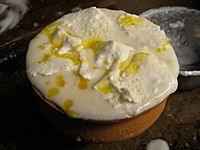
Fermented foods are made by changing carbohydrates (sugars) into alcohols or acids using tiny living things like yeasts or bacteria. This process is often done on purpose to create unique flavors and textures, and to preserve food.
Halal Food
Halal food follows Islamic dietary laws, which say what foods are "lawful" (halal) and "unlawful" (haram) to eat. These rules come from the Qur'an, the holy book of Islam.
Kosher Food
Kosher foods follow Jewish dietary laws, called kashrut. Food that is allowed by Jewish law is called kosher. Food that is not allowed is called treif.
Noodles
-
Various types of noodles from Southeast Asia
Noodles are a type of staple food made from dough that is rolled flat and cut into different shapes. They can be long and thin, wavy, or even shaped like shells. Noodles are usually cooked in boiling water and often served with sauce or in soup.
Pies
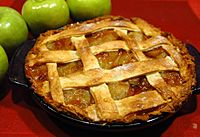
A pie is a baked dish, usually made with a pastry crust that covers or holds a filling. The filling can be sweet, like in an apple pie, or savory, like in a shepherd's pie.
Salads
-
A salad platter
A salad is a ready-to-eat dish, often with leafy vegetables, usually served cold or at room temperature. Salads often have a sauce or dressing. They can also include fruits, grains, meat, seafood, and sweets.
Sandwiches
-
A sandwich with chicken salad
A sandwich is food placed on or between slices of bread. It's a portable food that became popular in the Western world and is now found in many versions worldwide.
Sauces
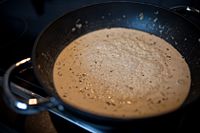
In cooking, a sauce is a liquid, cream, or semi-solid food served on or used to prepare other foods. Sauces add flavor, moisture, and make a dish look more appealing. The word "sauce" comes from a Latin word meaning "salted."
Snack Foods
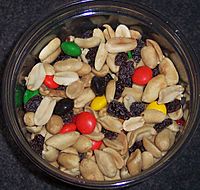
A snack food is a small portion of food, usually eaten between meals. Snacks can be packaged foods or items made fresh at home.
Soups
Soup is mainly a liquid food, usually served warm. It's made by combining ingredients like meat and vegetables with broth, juice, water, or another liquid. Hot soups are made by boiling solid ingredients in liquid to get their flavors out.
Stews
-
Lamb and lentil stew
Stew is a mix of solid food ingredients cooked in liquid and served with the resulting gravy. Stews can include any combination of vegetables (like carrots, potatoes, beans) and meats, especially tougher meats that become tender with slow cooking.
See also
- Cuisine
- Edible flowers
- List of beverages
- List of culinary herbs and spices
- List of food origins
- List of street foods
- Nutrition
- Organic food



